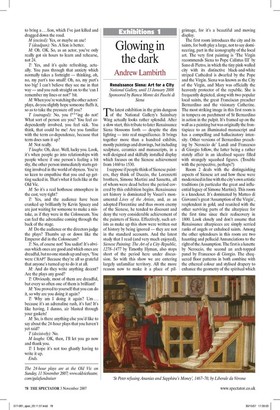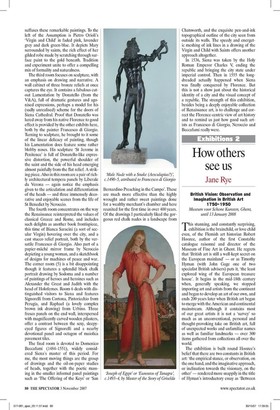Glowing in the dark
Andrew Lambirth Renaissance Siena: Art for a City National Gallery, until 13 January 2008 Sponsored by Banca Monte dei Paschi di Siena The latest exhibition in the grim dungeon of the National Gallery's Sainsbury Wing actually looks rather splendid. After a slow start, this tribute to later Renaissance Siena blossoms forth — despite the dim lighting — into real magnificence. It brings together more than a hundred exhibits, mostly paintings and drawings, but including sculpture, ceramics and manuscripts, in a well-designed and skilfully installed display which focuses on the Sienese achievement from 1460 to 1530.
I suppose if people think of Sienese painters, they think of Duccio, the Lorenzetti brothers, Simone Martini and Sassetta, all of whom were dead before the period covered by this exhibition begins. Renaissance art history is dominated by Vasari's monumental Lives of the Artists, and, as an adopted Florentine and thus sworn enemy of the Sienese, he tended to discount and deny the very considerable achievement of the painters of Siena. Effectively, such artists as make up this show were written out of history by being ignored — they are not in the standard accounts. And the latest study that I read (and very much enjoyed), Sienese Painting: The Art of a City-Republic, 1278-1477 by Timothy Hyman, also stops short of the period here under discussion. So with this show we are entering largely unfamiliar territory. All the more reason now to make it a place of pilgrimage, for it's a beautiful and moving display.
The first room introduces the city and its saints, for both play a large, not to say domineering, part in the iconography of the local art. The very first painting is 'The Virgin recommends Siena to Pope Calixtus III' by Sano di Pietro, in which the tiny pink-walled city with its distinctive black-and-white striped Cathedral is dwarfed by the Pope and the Virgin. Siena was known as the City of the Virgin, and Mary was officially the heavenly protector of the republic. She is frequently depicted, along with two popular local saints, the great Franciscan preacher Bernardino and the visionary Catherine. The most striking image in this first room is in tempera on parchment of St Bernardino in action in the pulpit. It's framed up on the wall as a painting but was originally the frontispiece to an illuminated manuscript and has a compelling and hallucinatory intensity. Other versions of Bernardino preaching by Neroccio de' Landi and Francesco di Giorgio follow, the latter being a rather stately affair in an idealised square filled with strangely squashed figures. (Trouble with the perspective, perhaps?) Room 2 deals with the distinguishing aspects of Sienese art and how these were modernised in line with the city's own artistic traditions (in particular the great and influential legacy of Simone Martini). This room is a knockout. It's dominated by Matteo di Giovanni's great 'Assumption of the Virgin', resplendent in gold, and reunited with the other surviving parts of the altarpiece for the first time since their rediscovery in 1800. Look closely and don't assume that Renaissance altarpieces are simply serried ranks of angels or enhaloed saints. Among the other splendours in this room are two haunting and pellucid Annunciations to the right of the Assumption. The first is a lunette by Neroccio, the second an arch-topped panel by Francesco di Giorgio. The chequered floor patterns in both combine with the ethereal colour and stylised drapery to enhance the geometry of the spiritual which suffuses these remarkable paintings. To the left of the Assumption is Pietro Orioli's 'Virgin and Child' in faded pink, lavender grey and dark green-blue. It depicts Mary surrounded by saints, the rich effect of her gilded robe made by scratching through surface paint to the gold beneath. Tradition and experiment unite to offer a compelling mix of formality and naturalness.
The third room focuses on sculpture, with an emphasis on drawing and narrative. A wall cabinet of three bronze reliefs at once captures the eye. It contains a fabulous cutout Lamentation by Donatello (from the V&A), full of dramatic gestures and agonised expressions, perhaps a model for his (sadly unrealised) scheme for the doors of Siena Cathedral. Proof that Donatello was lured away from his native Florence to good effect is provided by the other exhibits here, both by the painter Francesco di Giorgio. Turning to sculpture, he brought to it some of the linear delicacy of painting, though his Lamentation does feature some rather blobby noses. His sculpture 'St Jerome in Penitence' is full of Donatello-like expressive distortion, the powerful shoulder of the saint and the side of his head emerging almost painfully from the flat relief. A striking piece. Also in this room are a pair of richly architectural tempera panels by Liberale da Verona — again notice the emphasis given to the articulation and differentiation of the heads — and three immensely decorative and enjoyable scenes from the life of St Benedict by Neroccio.
The fourth room concentrates on the way the Renaissance reinterpreted the values of classical Greece and Rome, and includes such delights as another book frontispiece, this time of Bianca Saracini (a sort of secular Virgin) hovering over the city, and a cast stucco relief portrait, both by the versatile Francesco di Giorgio. Also part of a papier-mache mirror frame by Neroccio depicting a young woman, and a sketchbook of designs for machines of peace and war. The corner room (5) is a bit disappointing though it features a splendid black chalk portrait drawing by Sodoma and a number of paintings of heroes and heroines such as Alexander the Great and Judith with the head of Holofernes. Room 6 deals with distinguished visitors to Siena and features Signorelli from Cortona, Pintoricchio from Perugia, and Raphael (a lovely complex brown ink drawing) from Urbino. Three fresco panels on the end wall, interspersed with magnificently carved wooden pilasters, offer a contrast between the sexy, sleepyeyed figures of Signorelli and a nearby devotional panel and octagon of maiolica pavement tiles.
The final room is devoted to Domenico Beccafumi (1484-1551), widely considered Siena's master of this period. For me, the most moving things are the group of drawings and the oil-on-paper studies of heads, together with the poetic massing in the smaller informal panel paintings such as 'The Offering of the Keys' or 'San Bernardino Preaching in the Campo'. These are much more effective than the highly wrought and rather sweet paintings done for a wealthy merchant's chamber and here reunited for the first time in over 400 years. Of the drawings I particularly liked the gorgeous red chalk nudes in a landscape from Chatsworth, and the exquisite pen-and-ink topographical outline of the city seen from outside its walls. The speedy and energetic meshing of ink lines in a drawing of the Virgin and Child with Saints offers another approach altogether.
In 1536, Siena was taken by the Holy Roman Emperor Charles V, ending the republic and bringing the city state under imperial control. Then in 1555 the longdreaded actually happened when Siena was finally conquered by Florence. But this is not a show just about the historical identity of a city and the visual concept of a republic. The strength of this exhibition, besides being a deeply enjoyable collection of Renaissance art, is to challenge and correct the Florence-centric view of art history and to remind us just how good such artists as Francesco di Giorgio, Neroccio and Beccafumi really were.
Exhibitions 2













































































 Previous page
Previous page